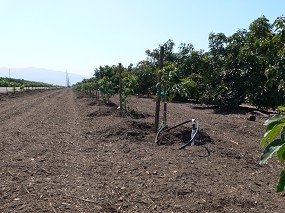- Author: Ben Faber
The canopy is thinning. The leaves are small and yellow. There is dieback in the canopy, with leafless tips on the branches. You dig around under the canopy in the wetted area of the sprinkler and you can't find roots within 6 inches of the soil surface or if you do find them they are black. There is little mulch under the tree. There are weeds growing under the tree. All these are signs of root rot disease. But it is also a sign of lack of water, because that is what is happening – there are no roots to take up water. And one of the things a gardener will often do, is start watering the diseased tree more, thinking it is lack of water, which if it is diseased only makes the condition worse. Adding more water to a tree that can not easily take it up only creates an asphyxiation that makes matters worse. Irrigation and mulch are the two most important factors for avoiding the disease.
So what do you do if you have disease? There are fungicides that are available from the nursery, but there are a number of things that you can do before applying something like that. First of all get a handle on the irrigation. Make sure you are irrigating to the tree's needs. Check soil moisture before irrigating. Make sure the tree is not getting supplemental water from another area such as a lawn sprinkler. Make sure there is a good thick, woody mulch under the canopy. Adding gypsum (15-20 pounds per tree) evenly spread under the canopy can also help, but reviewing and modifying the irrigation practice is the most important thing that you can do.

- Author: Ben Faber
I've been getting calls and have gone out to see several avocado orchards in the Ventura/Santa Barbara area and the comments are that the trees look worse this year than they normally do. When I see the trees, it's clear that they don't look in the best shape. This time of year, when there are old leaves that have accumulated salt all through the irrigation period and the trees are getting ready to flower, the leaves just don't have much energy. Also, two years of drought with no rain, means that salts have probably accumulated more by this time of year, than in a year when we do have “normal” rain to leach the soil. The accumulated salts can lead to water stress which also brings on stem and leaf blight, along with salt burn. With the bicarbonates in the water, the pH may have rise as well, inducing some iron chlorosis. Compounding the leaf damage is some frost burn, which was not cold enough to kill the leaves. Any dead tissue, also makes the leaves look more ratty, because with Santa Ana winds earlier, those dead areas have often blown out, making them look like they have been nibbled on by insects. Further adding to the stress was a huge crop year that put a lot of stress on the tress. When clearing the leaves to look at roots, it has often been hard to find viable roots. All these stresses are going to make the trees more susceptible to root rot. So it's going to be necessary for growers to keep their eyes out for further disease symptoms and to be ready to treat with phosphites when the soil warms up enough for the roots to start growing again.
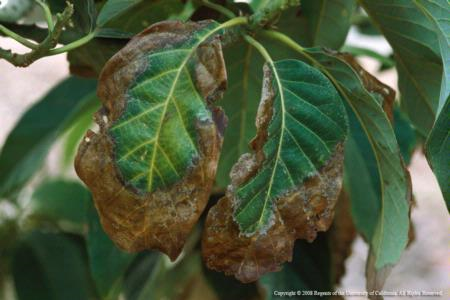
- Author: Ben Faber
There is a running debate about whether avocado canopies should be skirted up, raised up so that you can see under the canopy. In doing so, the tree’s tendency is to maintain its bearing volume by increasing a similar amount in height that is lost by removing the bottom layer of canopy. A tree with a full canopy is more cold resistant because it traps heat inside the canopy and is not so prone to cold winds. In an inversion freeze, though, warming air from irrigation, wind machines and orchard heaters is less likely to circulate when the skirts block air movement. A low skirt also impedes a uniform application of water from microsprinklers, and hence fertilizer distribution. A low skirt also has more fruit lying on the ground which is more uneven in coloration and more prone to disease and possibly food safety issues. A raised skirt also promotes more air circulation within the canopy which can reduce the incidence of some other diseases of both fruit, stems and branches.
A raised skirt, though exposes the base to light, and if there is no leaf mulch, there are more weeds to control. In the case of hillsides, because of gravity and wind exposure, leaves tend to blow away. The roots are now more exposed to drying because of increased evaporative loss. Loss of leaves is also a major disease problem, since leaves and organic matter are the first lines of defense (after proper irrigation management) against Phytophthora root rot. It is the microorganisms breaking down the leaves that create a hostile environment for the Phytophthora pathogen. In fact, in releasing enzymes to break down organic matter, the microorganisms also break down the cell walls of Phytophthora which are made of the same material as leaves. An orchard with no leaves is wide open to root rot infection.
So I propose something modest. On flat ground where trees are more prone to frost damage, and less subject to winds blowing away leaves that the trees are skirted. On slopes, though where winds blow away leaves and the trees are less subject to low lying cold, that the skirts are left. To maintain a more even water distribution, though, windows are cut into the canopy on the side facing the microsprinkler so that the canopy does not interfere with water spray.

- Author: Ben Faber
In the last two weeks I’ve been out to see groves that have root rot, yet the growers did not recognize the signs. Two years of drought and use of salt loaded water have put stress on trees and made them more susceptible to root rot. Although irrigation management can bring about the symptoms of root rot – small, yellow, tip-burned leaves – because the tree in both cases is seeing a lack of water. I thought it would be appropriate to review the symptoms of avocado root rot.
What to look for:
Small, yellow, tip-burned leaves
Thin canopy
Die-back in the canopy, causing stag-horning (dead stems)
Little or no new leaf growth, hardened look to the leaves
Few or no leaves on the ground (tree doesn’t have energy to produce leaves)
Profuse flowering and small fruit
Sunburned fruit from reduced canopy
Then get on your knees and dig around in the wetted area of the root zone
Do you find roots in the top 3 inches of soil? NO, that’s a bad sign
Do you find any white root tips (it’s hard to find these when the soil is cold in the winter)? NO, that’s a bad sign.
Do you find black roots? Yes, that’s a bad sign.
These are all field diagnostics for avocado root rot. You can also sample roots and send them in for lab analysis, but in the winter, the root rot organisms are not active and you can actually get a false negative. Meaning the lab won’t pick it up and you then think you don’t have the disease. Use field clues to figure out whether you have root rot. Then figure out why you have it. It usually boils down to the amount and timing of water, but there are many other factors, such as water quality, fruit load, topworking and other stresses that can bring on the disease.
Images. Root rot in canopy, leaves and roots
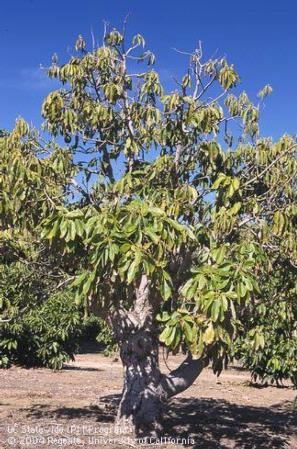
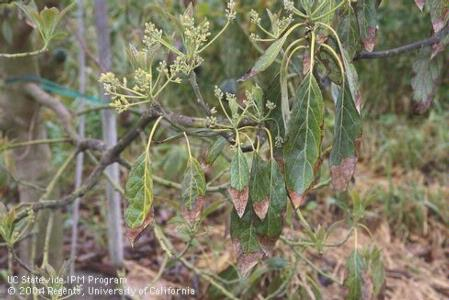
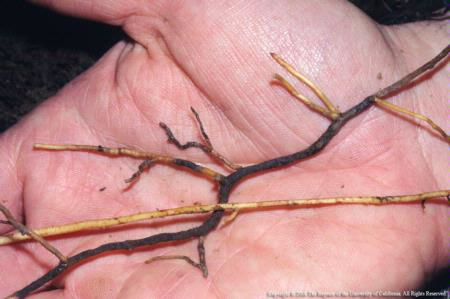
- Author: Ben Faber, University of California Cooperative Extension
- Author: Michael Spiers, HortResearch, Ruakura, New Zealand
Biological control of Phytophthora cinnamomi in avocado through the use of mulches was identified by an Australian grower and later described as the "Ashburner Method" by Broadbent and Baker. The technique uses large amounts of organic matter as a mulch along with a source of calcium. Control of avocado root rot in the Ashburner method was attributed to the presence of Pseudomonas bacteria and Actinomycetes. Multiple antagonists are more likely the cause of biological control, since no single organism has been found to be consistently associated with soils suppressive to P. cinnamomi.
The use of organic mulches has multiple effects, such as altered soil nutrient and water status and improved physical structure. Any improvements in plant status resulting from improvements in the growing environment can improve plant health. The effect of organic amendments on soil physical and chemical properties can vary considerably depending on soil texture and the environment. One of the most consistent effects of organic amendments is an increase in biological activity. Increases in organic substrate lead to increased fungal and bacterial populations. In numerous cases, this increase in biomass has been associated with disease suppression. This biological control can be ascribed to several mechanisms: competition, antibiosis, parasitism, predation and induced resistance in the plant.
The microbial biomass is responsible for release of enzyme products and polysaccharides in soils. The microbially-produced enzymes cellulase and glucanase have been demonstrated to have a significant effect on Phytophthora populations. This mechanism of antibiosis is possible because the microbes are releasing these enzymes to solubilize organic matter. Unlike other fungi, Phytophthora have cell walls that are comprised of cellulose and in the process of decomposing organic matter with enzymes, an environment is created that is also hostile to the pathogen.
In order to see if there might be potential differences in organic materials being better at combating avocado root rot, a little field trial was established with 23 different types of materials. The mulch materials were obtained from nearby hedges and chipped or obtained from commercial sources of mulch. Some of these materials would be difficult to get in large amounts, such as manuka (Leptospermum scoparium), but others are commercially available chipped greenwaste. The materials were then spread on the ground to a depth of five inches, in separate plots that were 36 X 36 inch squares. Decomposition was measured over a two year period and then cellulase was measured in the mulch, at the soil / mulch interface and at a two inch depth in the soil at the end of 2 years.
Since cellulase production is part of the decomposition process, the rate of decomposition should be a partial indicator of the amount of cellulase present. After a mulch application there is generally settling due to rainfall-caused compaction, but much of the decline by the second year is due exclusively to decomposition. The more recalcitrant materials, such as bark, wood chips and sawdust have barely lost half their depth after two years, while others such as shredded eucalyptus, manuka, avocado and willow are less than 20% of their initial depth. Much of the shredded/chipped material, such as eucalyptus had a significant fraction of leaves in the mulch. The wool disappeared a little after one year. The greenwaste + chicken manure compost is nearly the same depth as the wood chips, since it is a material that had gone through a decomposition process prior to its application and much of the easily digestible materials had already been decomposed.
The rate of decomposition has some bearing on the rate of cellulase production. Eucalyptus and manuka had the two greatest rates of decomposition and show the highest levels of cellulase production. The cellulase levels were consistent with all the different mulch materials. Using decomposition rate alone is not a complete indicator of cellulase production since, poplar, willow and avocado had high rates of decomposition, but their cellulase rates were half those of manuka and eucalyptus.
It is clear that the cellulase effect is limited to the layer of mulch and not to depth within the soil. There is some effect at the soil surface, but at 5 cm (2 inches) cellulase activity drops to background levels. There is earthworm activity at the test sites and one idea was that earthworm incorporation of organic matter would move the cellulase production into the soil. Maybe with further time this would occur. As it is, when mulches are applied to avocado, the roots tend to proliferate in the mulch, out of the soil where the cellulase activity is the least.
Something to keep in mind is that we do not know what levels of cellulase are necessary to control the root rot fungus. It may be that levels seen with pine bark are more than adequate. Also we have measured cellulase production at only one time in a two-year period and it is quite likely that this is not the best snapshot of what is happening before and after. A further reminder is that cellulase is only one of the many byproducts associated with decomposition and many of the antagonistic properties that are associated with the microbial biomass are not being measured in this trial. Having developed this screening procedure what needs to be done next is to take high, medium and low cellulase producing mulches and challenge the fungus to verify that this is a good way to evaluate mulches.
